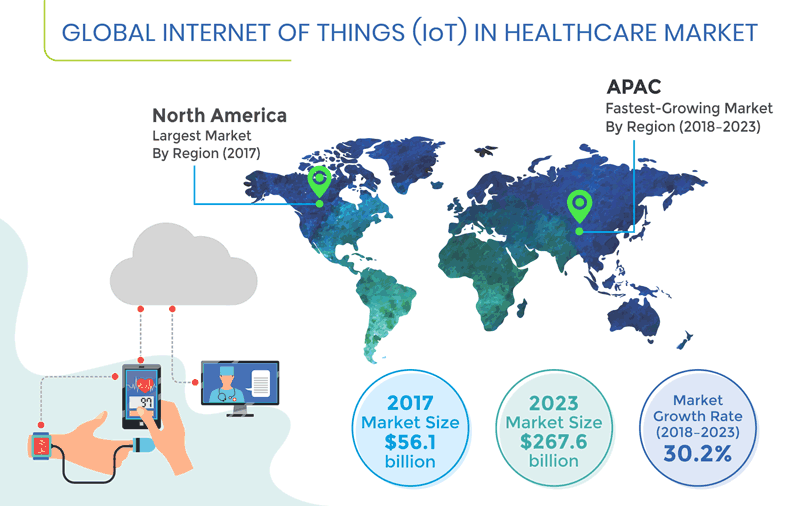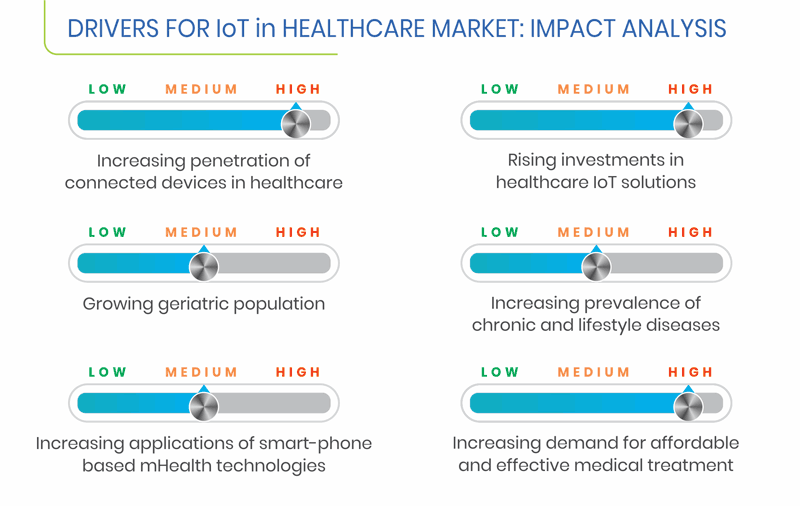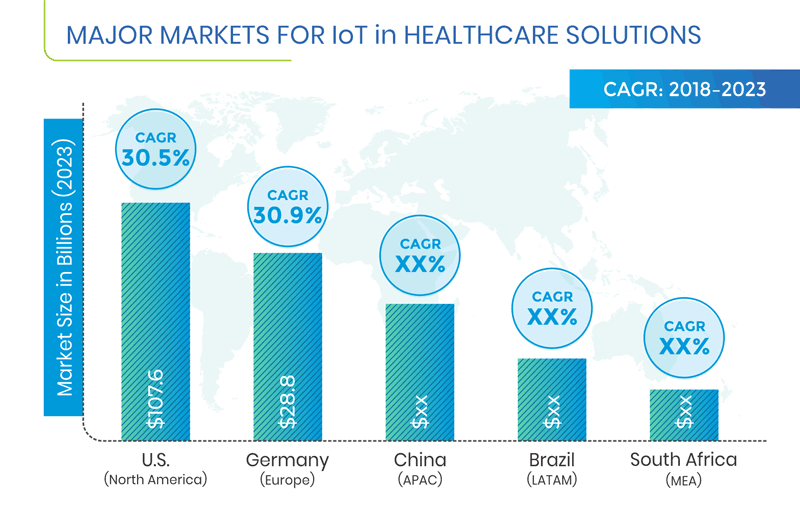Report Code: 10589 | Available Format: PDF | Pages: 339
IoT in Healthcare Market Research Report: By Component (Medical Devices, Systems and Software, Services), Technology (Wi-Fi, Bluetooth Low Energy, Near Field Communication, Zigbee, Cellular, Satellite), Application (Telemedicine, Clinical Operations and Workflow Management, Connected Imaging, Inpatient Monitoring, Medication Management) End User (Hospitals, Surgical Centers, and Clinics, Clinical Research Organizations, Research and Diagnostic Laboratories) - Global Industry Size, Share, Growth, Trends and Forecast to 2023
- Report Code: 10589
- Available Format: PDF
- Pages: 339
- Report Description
- Table of Contents
- Market Segmentation
- Request Free Sample
Valued at $56.1 billion in 2017, the global internet of things (IoT) in healthcare market is expected to generate revenue worth $267.6 billion by 2023, registering a CAGR of 30.2% during the forecast period (2018–2023).
Among all regions, APAC is expected to be the fastest-growing market for IoT in healthcare, demonstrating a CAGR of 34.4% during the forecast period. Increasing prevalence of chronic and lifestyle-related diseases coupled with the rising demand for better medical facilities is the key factor boosting investments in the healthcare information technology (HIT) in the region.

Factors Governing IoT in Healthcare Market
Players in the IoT in healthcare market are actively focusing on strategic measures such as partnerships and collaborations to provide technologically advanced solutions to healthcare organizations for improved services. For instance, in March 2018, Koninklijke Philips N.V. entered into a partnership with Hologic Inc. to offer novel, integrated imaging solutions for women's healthcare. These solutions included diagnostic imaging modalities and informatics technologies for screening medical conditions in women. With such partnerships and collaborations, companies are trying to cater to the growing demand for advanced healthcare solutions and, in the process, increase their share in the market.
The IoT in healthcare market is also being driven by increasing investments in IoT by both public and private organizations across the world. For instance, in November 2015, the European Union (EU) launched the Connecting Europe Facility (CEF) program and invested $18.2 million for the deployment of digital service infrastructure (DSI). The CEF invited proposals from EU member states to provide pan-EU digital services in four different areas: eHealth, eProcurement, eIdentification (eID), and online dispute resolution (ODR). In the U.K., the government launched IoTUK, a three-year national program, with an investment of $52.8 million for the development of the country’s IoT network.

Healthcare organizations across the world are increasingly deploying cloud-based solutions for the seamless exchange of patient information. Cloud computing supports storage and retrieval of a huge volume of patient information, further facilitating better clinical management in hospitals and other emergency care settings. IoT-supported cloud platforms allow physicians, nurses, and other healthcare professionals to access comprehensive data sets with respect to patient health records in real-time for making informed decisions. Owing to these benefits of cloud technology in the healthcare industry, healthcare providers are opting for this technology for improving clinical workflow, thus boosting the demand for IoT solutions globally.
IoT in Healthcare Market Segmentation Analysis
The systems and software category is expected to be the fastest-growing component category in the IoT in healthcare market, advancing at a CAGR of 32.9% during the forecast period. Furthermore, of the various application areas of the IoT technology in healthcare, telemedicine accounted for the largest share in the market. Also, during the forecast period, the IoT in healthcare market is expected to witness the fastest growth in the Wi-Fi category. These findings may be attributed to the increasing adoption of the technology, as Wi-Fi-supported IoT solutions in healthcare help in seamless data sharing and continuous patient monitoring, thus reducing the number of hospital visits and resulting in improved patient outcomes.
Hospitals, surgical centers, and clinics, as an end-user category, accounted for the largest share in the IoT in healthcare market in 2017, mainly due to the rise in the number of clinics and hospitals, globally.
| Report Attribute | Details |
Historical Years |
2013-2017 |
Forecast Years |
2018-2023 |
Market Size by Segments |
Component, Technology, Application, End User |
Market Size of Geographies |
U.S., Canada, Germany, France, U.K., Italy, Spain, China, Japan, India, Australia, Brazil, Mexico, South Africa, Saudi Arabia, U.A.E. |
Explore more about this report - Request free sample
Geographical Analysis of IoT in Healthcare Market
Globally, North America was the largest market for IoT solutions in healthcare, contributing 44.3% revenue in 2017. Some of the factors driving the North American IoT in healthcare market are the developed healthcare infrastructure, increasing government initiatives to boost the adoption of IoT solutions in healthcare, and growing prevalence of chronic diseases in the region. Additionally, increasing R&D activities in the HIT sector and advancements in technology have significantly contributed to the market growth in the region.
In terms of growth, APAC is projected to be the fastest-growing IoT in healthcare market globally, primarily driven by the increasing investments by public and private organizations in the HIT sector, surging geriatric population, and rising prevalence of chronic diseases in the region.

Competitive Landscape of IoT in Healthcare Market
The global IoT in healthcare market is consolidated in nature. Some of the key players operating in the market are Stanley Black & Decker Inc., Proteus Digital Health Inc., and Medtronic plc. These players are mainly focusing on mHealth applications, wearable sensors, and health analytics solutions supported by IoT.
Recent Strategic Developments of Major Market Players
In recent years, players in the IoT in healthcare market have taken several strategic measures, including product launches and partnerships, to increase their market share. For instance, in February 2018, GE Healthcare launched LOGIQ E10, a high-end radiology ultrasound system that is fully digital and supported by cloud connectivity, artificial intelligence technology, and advanced algorithms to obtain and reconstruct data for accurate diagnosis.
Similarly, in November 2017, Otsuka Pharmaceutical Co. Ltd. (Otsuka) and Proteus Digital Health (Proteus) announced the U.S. Food and Drug Administration (USFDA) approval of the ABILIFY MYCITE (aripiprazole tablets with sensor) digital medicine system, a drug–device combination product comprising Otsuka’s oral aripiprazole tablets embedded with an ingestible event marker (IEM) sensor.
IOT Healthcare Market Size Breakdown by Segment
The internet of things (IOT) healthcare market report offers comprehensive market segmentation analysis along with market estimation for the period 2013–2023.
Based on Component
- Medical Devices
- Wearable External
- Implanted
- Stationary
- Systems and Software
- Remote Device Management
- Network Bandwidth Management
- Data Analytics
- Application Security
- Network Security
- Services
- System Integration
- Professional
- Support and Maintenance
Based on Technology
- Wi-Fi
- BLE
- NFC
- ZigBee
- Cellular
- Satellite
Based on Application
- Telemedicine
- Remote Patient Monitoring
- Store-and-Forward Telemedicine
- Interactive Telemedicine
- Clinical Operations and Workflow Management
- Connected Imaging
- Inpatient Monitoring
- Medication Management
Based on End User
- Hospitals, Surgical Centers, and Clinics
- Clinical Research Organizations
- Research and Diagnostic Laboratories
Geographical Analysis
- North America
- U.S.
- Canada
- Europe
- Germany
- France
- Italy
- U.K.
- Asia-Pacific (APAC)
- China
- Japan
- India
- Australia
- Latin America (LATAM)
- Brazil
- Mexico
- Middle East and Africa (MEA)
- South Africa
- Saudi Arabia
- U.A.E.
Key Questions Addressed in the Report
- What is the current scenario of the global IoT in healthcare market?
- What are the historical and the present size of the categories under market segments and their future potential?
- What are the major catalysts for the market and their impact during the short, medium, and long terms?
- What are the recent trends and evolving opportunities for the players in the market?
- Which are the key regions from the investment perspective?
- What are the key strategies being adopted by the major players to increase their market share?
Want a report tailored exactly to your business strategy?
Request CustomizationWant an insight-rich discussion with the report author?
Speak to AnalystOur dedication to providing the most-accurate market information has earned us verification by Dun & Bradstreet (D&B). We strive for quality checking of the highest level to enable data-driven decision making for you
Our insights into the minutest levels of the markets, including the latest trends and competitive landscape, give you all the answers you need to take your business to new heights
With 24/7 research support, we ensure that the wheels of your business never stop turning. Don’t let time stand in your way. Get all your queries answered with a simple phone call or email, as and when required
We take a cautious approach to protecting your personal and confidential information. Trust is the strongest bond that connects us and our clients, and trust we build by complying with all international and domestic data protection and privacy laws